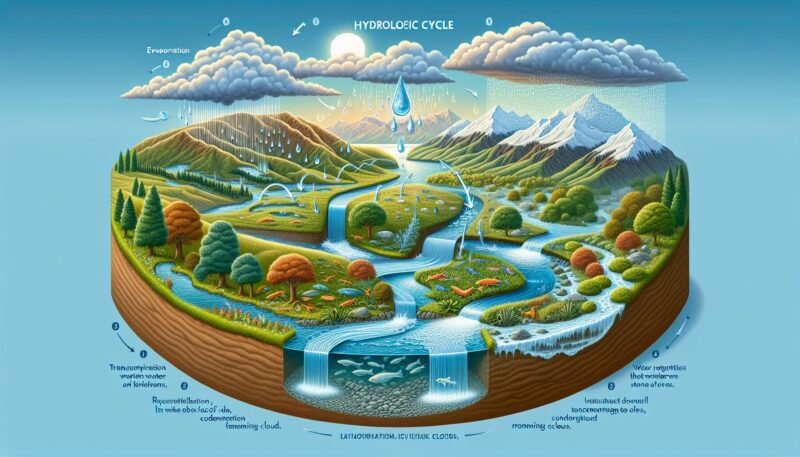The hydrologic cycle, also known as the water cycle, is a continuous process that describes the movement of water on, above, and below the surface of the Earth. This cycle is fundamental to life as it governs the distribution and availability of fresh water, which is essential for all biological organisms, including humans. Let’s dive into a detailed exploration of how the hydrologic cycle functions, the roles it plays in our ecosystems, and the impact that human activities have on this critical natural system.
Introduction to the Hydrologic Cycle
The hydrologic cycle is an intricate system that involves various processes by which water circulates through the planet’s hydrosphere. It is driven by solar energy, and consists of numerous interconnected stages: evaporation, transpiration, condensation, precipitation, infiltration, percolation, and runoff. Each stage plays a crucial part in maintaining the balance of Earth’s water resources.
Evaporation
The sun’s heat causes water to evaporate from the surface of oceans, rivers, lakes, and other bodies of water. This process also includes the evaporation of moisture from the soil and other land surfaces. Evaporation converts liquid water into water vapor, which rises into the atmosphere.
Transpiration
Plants also contribute to the hydrologic cycle through a process called transpiration. This is the release of water vapor from plant leaves during photosynthesis. Transpiration and evaporation together are often referred to as evapotranspiration.
Condensation
As water vapor rises into the atmosphere, it cools and changes back into liquid droplets through condensation. This is the process that forms clouds and fog.
Precipitation
When droplets in clouds combine and grow large enough, they fall to the Earth’s surface as precipitation, including rain, snow, sleet, or hail.
Infiltration
Once precipitation reaches the ground, some of it infiltrates, or seeps into the soil, contributing to soil moisture and recharging groundwater.
Percolation
The infiltrated water continues downward, percolating through soil and rock layers to replenish aquifers, which are underground layers of water-bearing permeable rock or unconsolidated materials.
Runoff
Not all precipitation penetrates the ground. Some of the water runs off the surface and collects in puddles, streams, rivers, and eventually returns to the oceans. The speed and volume of runoff can be affected by factors such as land slope, vegetation, soil type, and land use.
Streamflow and Baseflow
Streamflow, or the flow of water in streams and rivers, is influenced by runoff and baseflow, which is the sustained flow contributed by groundwater seeping into a watercourse.
The Importance of Groundwater
Groundwater is a crucial component of the hydrologic cycle. It fills the voids and cracks in underground materials, and it’s a vital source of water for humans, supplying nearly half of all drinking water worldwide. Aquifers, the natural reservoirs of groundwater, are tapped for agricultural, industrial, and domestic use through wells.
Recharge and Discharge
Groundwater systems are dynamic, with aquifers being naturally recharged by infiltrating water. Discharge occurs when groundwater flows out of the aquifer into springs, streams, lakes, or the ocean. Balance between recharge and discharge is vital for maintaining groundwater levels and ensuring long-term sustainability.
Watersheds and Drainage Basins
A watershed, also known as a drainage basin or catchment, is an area of land where all of the water under it or draining off of it collects into the same place. Watersheds are separated from each other by geographical barriers such as mountains or ridges. They play a critical role in collecting precipitation and channeling it into streams and rivers.
The Human Influence
Human activities have a significant impact on the natural hydrologic cycle:
-
Water Pollution: Pollution from agricultural runoff, wastewater discharge, and industrial processes can degrade water quality, affecting ecosystems and human health.
-
Water Withdrawal: Large-scale water abstraction for irrigation, industrial processes, and consumption disrupts the natural balance, leading to problems like reduced streamflow and groundwater depletion.
-
Climate Change: Alterations in global temperatures and weather patterns modify the dynamics of evaporation, precipitation, and runoff, leading to changes in water availability.
-
Urbanization: The replacement of natural landscapes with impermeable surfaces increases runoff and reduces infiltration, affecting groundwater recharge and exacerbating flooding.
-
Deforestation: Trees contribute significantly to transpiration and interception (capture of precipitation by vegetation). Removing trees reduces these processes and impacts the hydrologic cycle.
Water Management Solutions
To mitigate human impacts on the hydrologic cycle, various water management strategies are employed:
-
Water Conservation: Implementing efficient water use practices, such as drip irrigation and low-flow fixtures, can reduce unnecessary waste of water resources.
-
Rainwater Harvesting: Collecting and storing rainwater for reuse can supplement water supply and reduce dependency on surface and groundwater.
-
Wetland Preservation: Protecting and restoring wetlands, which act as natural water filters and flood control systems, are important for maintaining a healthy hydrologic cycle.
-
Integrated Water Resource Management (IWRM): IWRM approaches involve managing water resources in a comprehensive, equitable, and sustainable manner, taking into account all competing water usages and the interconnectedness of the hydrologic cycle.
Conclusion
The hydrologic cycle is a complex and essential system that sustains life on our planet by ensuring the availability of freshwater. As our understanding of this cycle grows, so does our recognition of the importance of protecting and managing our planet’s water resources responsibly. Through careful stewardship and sustainable practices, we can help to preserve the delicate balance of the hydrologic cycle for future generations.
To gain further insights into the hydrologic cycle and its implications for our environment, readers may explore resources provided by the United States Geological Survey (USGS) on their Water Science School page and the Environmental Protection Agency (EPA) on their Water Topics website.
References
- USGS Water Science School. (n.d.). The Hydrologic Cycle. Retrieved from https://www.usgs.gov/special-topic/water-science-school/science/hydrologic-cycle.
- EPA Water Research. (n.d.). Water Topics. Retrieved from https://www.epa.gov/water-research.
